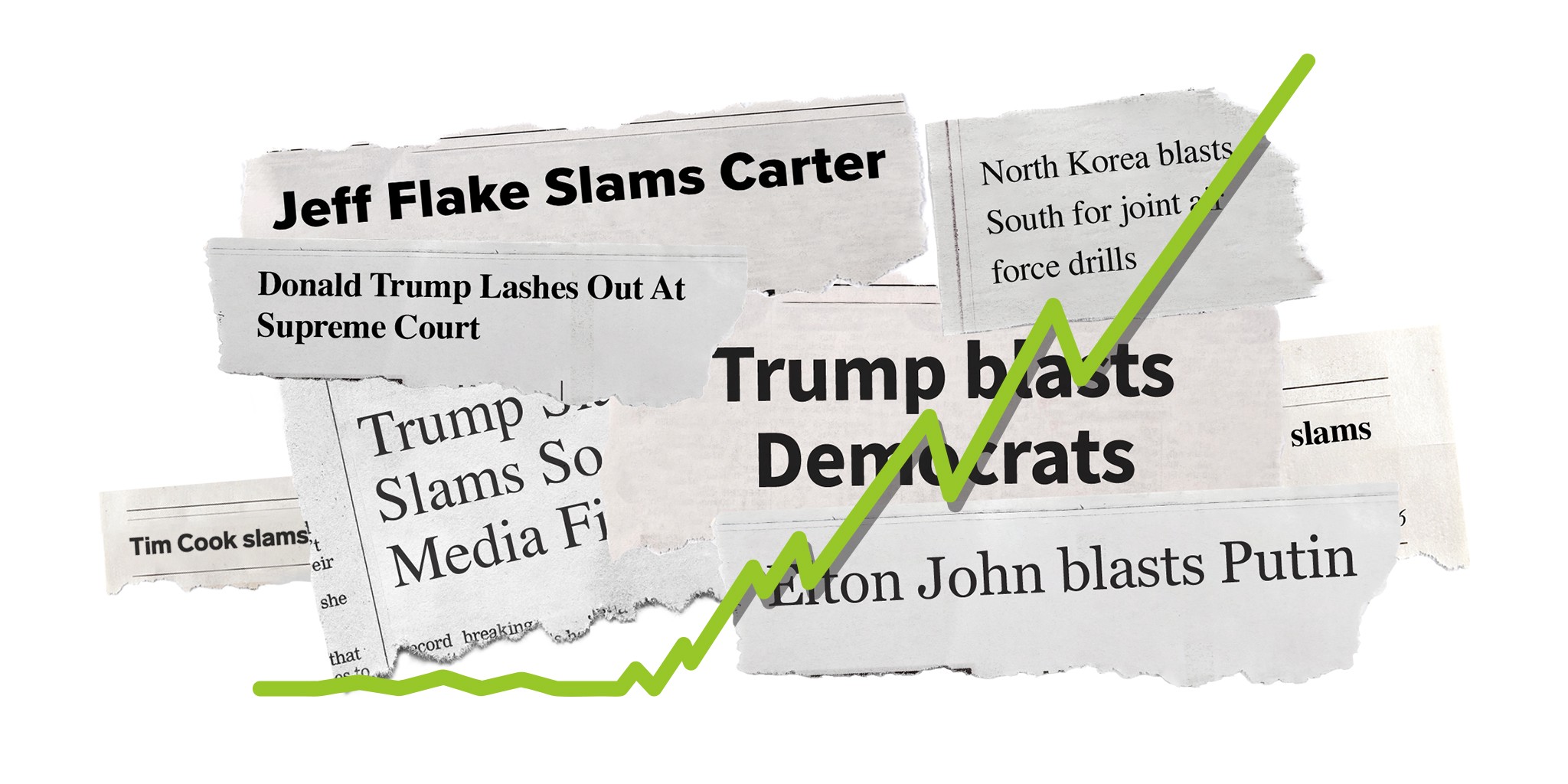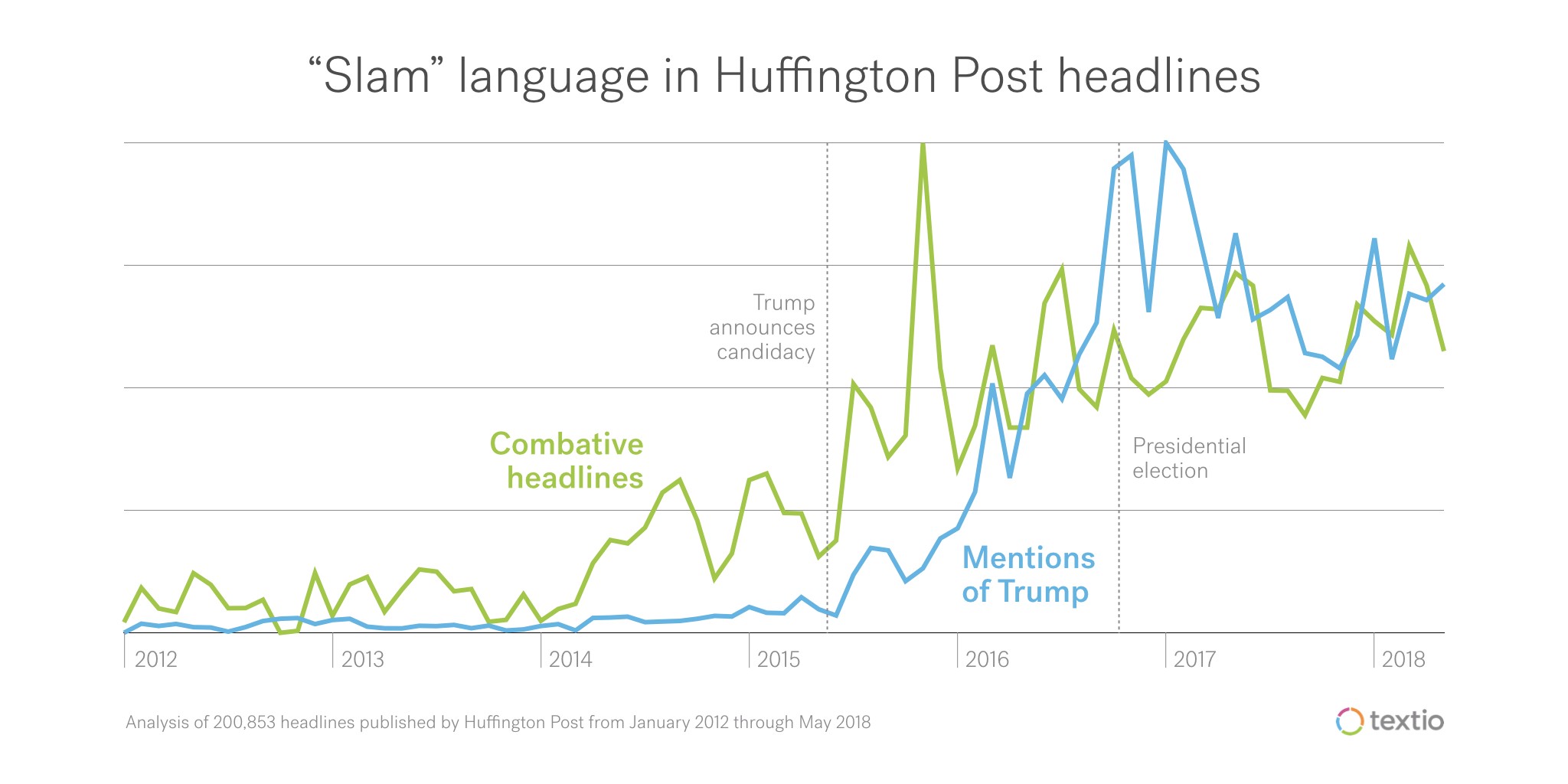The Rise of “Slam” Journalism

A few months ago, as I was catching up on the news, something about this New York Times headline caught my eye:
Many of us would agree that the current American political climate is unusually combative, so the fact that public figures trading insults made front-page news didn’t come as much of a surprise. But I was surprised by a specific word choice in the headline itself.
Since when are public figures slamming each other, instead of simply disagreeing? The sentiment of a word like slam is unmistakably aggressive, even violent, invoking WWE-style body slams. Trump doesn’t just respond to criticism; he blasts his critics. The Undertaker doesn’t simply jump on top of his opponents; he body slams them.
I can’t think of a single time I’ve said the word slam out loud in the context of political news. But media outlets are definitely using it—and they’re using it a lot. A quick skim of recent headlines reveals these gems:
-
“Trump Slams Russia Investigation And Green New Deal At CPAC” (NPR)
-
“Democrats Blast Biden For Recalling ‘Civil’ Relationship With Segregationists” (CNN)
-
“Ocasio-Cortez slams Jerry Falwell Jr. in debate over CPAC comments” (Fox News)
It seems safe to conclude that violent verbs are popular in news headlines today (go look up “slam” in Google News if you’re still not convinced), but has this always been the case? Did Donald Trump’s unusually combative candidacy and presidency unwittingly inspire a trend towards using more combative language in headlines? Using real data from recent news headlines, we can begin to answer these questions.
Did Trump invent the “slam?”
It’s reasonable to suspect that the rise in partisan sparring during and after Donald Trump’s candidacy might have coincided with an increase in violent verbs in headlines.
With a list of violent verbs and a dataset in hand (200,000 Huffington Post headlines from 2012–2018), I set out to looking for a trend and was taken aback by what I found.

As the graph above clearly shows, Trump’s campaign announcement coincided with a dramatic increase in mentions of Trump and combative language in headlines. In fact, the two trends have a correlation coefficient of over 0.8, indicating a very strong relationship. In other words, as the Huffington Post wrote more about Trump, they used more violent language.
As the Huffington Post wrote more about Trump, they used more violent language
Interestingly, the graph above shows that the trend of using more violent verbs continues well beyond the electoral campaigns and into the Trump presidency. This suggests that this language did not rise and fall with the political squabbles of the 2016 election, and is in fact an enduring trend in headlines today.
But that headline data is limited to the Huffington Post. Does the heavy usage of violent verbs hold up when we look at headlines across a broad range of media outlets?
Everyone is slamming now
With a little sleuthing, I discovered an additional dataset containing 140,000 headlines from over a dozen media outlets. It spans a limited time range (2015–2017), but can still provide a rich view into the headlines of different outlets covering the same recent world events.

You can quickly see that this type of headline is not unique to the Huffington Post. In fact, HuffPo is in the lower half of this group in terms of how often they put words like “slam” in their headlines.
In addition, the range of frequencies is fairly wide, from 1/10th of a percent for The Atlantic, up to more than 2% of headlines found on Business Insider. Given the correlation of “slam” headlines to Trump’s political ascendancy, one might assume that there is also a correlation to political partisanship among different media outlets. But in fact, the data doesn’t prove this out. There seems to be no relationship whatsoever between an outlet’s political bias and the number of times they “blast” headlines.

Who is getting slammed?
Using the same data source as above, I searched for occurrences of “Trump” before and after the violent verbs in question to get a rough estimate of how often he delivers or receives a slam. This allowed me to calculate how much more (or less) likely an outlet was to write that Trump was on the receiving end of this language.
Looking at the top six heaviest users of violent verbs, a fascinating pattern emerges. Overall, the news outlets using the most combative language are more likely to say that Trump is the recipient of slams and blasts.

Adding in estimates of partisanship makes things even more fascinating. As outlets lean towards the right in the partisan divide, they become less likely to write that Trump is the recipient of violent language than their more liberal counterparts. Talking Points Memo is an interesting exception and the only media source in the highest usage group that’s more likely to say Trump is delivering slams and blasts.
It is striking that even as usage of violent verbs remains constant, there are clear distinctions in which direction the hits are being applied across news outlets, correlating with their partisan bent.
Headlines Matter
What have we learned from all this data about headline language trends?
- News editors are writing headlines to gain clicks
- Our current political environment is highly combative
- Some news outlets have political bias
So what else is new.
News editors would undoubtedly tell us that they’re simply mirroring broader cultural trends over which they have no control. Nearly every digital media outlet does real-time A/B testing on their headlines, including the New York Times. So they would probably say that they’re just speaking the language that resonates with their audience best.
It remains to be seen whether “slam journalism” is a permanent trend or just a bump in the road. It may have arisen out of the media’s relationship with Trump’s presidential candidacy, but that doesn’t mean it will end as soon as he leaves office. So stay tuned as our language and culture continue to evolve.